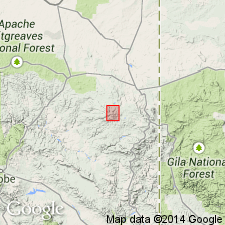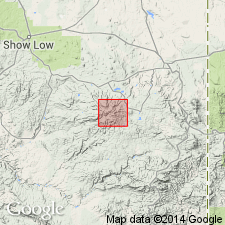
- Usage in publication:
-
- Smith Cienega glaciation
- Modifications:
-
- Named
- Dominant lithology:
-
- Till
- AAPG geologic province:
-
- Black Mesa basin
Summary:
Named for Smith Cienega in upper reaches of Ord Creek, White Mountains of Apache Co, AZ in the Black Mesa basin. No type locality designated. Occurs (extent map) in many valleys -West Fork of Black River, West Fork of Little Colorado River, Ord Creek, Paradise Creek, East Fork of White River. Moraines well preserved. Soils have a 3-7 cm A-horizon and a 20-30 cm B-horizon. Subaerial weathering has developed a 7-10 mm thick weathering rind on the erratics, and pits have started to develop. Degree of weathering suggests early Wisconsin age. Is intermediate in age between Purcell glaciation (named) and Baldy Peak glaciation (named). Correlation chart.
Source: GNU records (USGS DDS-6; Denver GNULEX).

- Usage in publication:
-
- Smith Cienega glaciation
- Modifications:
-
- Overview
- AAPG geologic province:
-
- Black Mesa basin
Summary:
Till of this glaciation is not indurated. It can be classed as gravelly-sand or sandy gravel. It is poorly sorted, positively skewed, and a mesokurtic distribution. Erratics as large as 2m x 4m common. Staining present on erratics to depth of 5 cm. Erratics have a weathering rind less than 2 cm thick and 1 cm deep. Soils on the till are immature exhibiting A, B, and C horizons. The till may be 20 m or more thick. Glacio-lacustrine deposits (intercalated clay, peat, mud) occur on sides of ridges and behind moraines in valley bottoms. Glaciofluvial deposits occur downstream from the terminal moraine; they are poorly sorted, symmetrical, and very leptokurtic. Volume of glaciofluvial deposits is small. Moraines are well preserved. Smith Cienega glaciers not as extensive as the glaciers of the older or Purcell glaciation (named). Is intermediate between the Purcell and Baldy Peak (named) glaciation. Degree of preservation suggests early Wisconsinan age.
Source: GNU records (USGS DDS-6; Denver GNULEX).
For more information, please contact Nancy Stamm, Geologic Names Committee Secretary.
Asterisk (*) indicates published by U.S. Geological Survey authors.
"No current usage" (†) implies that a name has been abandoned or has fallen into disuse. Former usage and, if known, replacement name given in parentheses ( ).
Slash (/) indicates name conflicts with nomenclatural guidelines (CSN, 1933; ACSN, 1961, 1970; NACSN, 1983, 2005, 2021). May be explained within brackets ([ ]).

